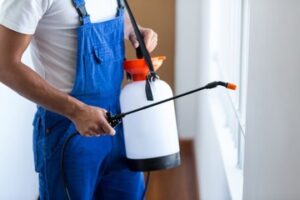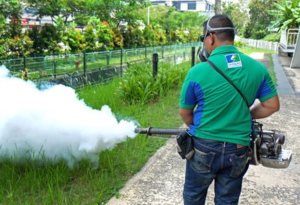Pest control includes the removal and management of rodents, birds, insects and other organisms that damage property or cause discomfort. These services may include exclusion, repulsion, quarantine, physical removal and the use of chemical or biological controls including sterilization programmes. Contact Pest Control Shawnee KS for professional help.

Focus on what makes your business different from the competition. This might be your expertise in removing certain types of pests or your speed in responding to client needs.
The goal of preventive pest control is to keep pests from becoming a problem in the first place. This can be accomplished by blocking them from entering buildings, using barriers to stop their progress, and eliminating their food and shelter sources. Preventive actions also include sanitary maintenance to discourage pests and reducing attractants. Taking advantage of natural controls, such as birds, amphibians, reptiles, and fish that feed on or parasitize pests, is another good way to reduce the need for chemical pesticides.
Prevention can involve examining the environment for places where pests like to hide, and creating a system of monitoring that makes it easier to notice pest activity. For example, it is a good idea to inspect storage areas to make sure that everything in there is tightly sealed and there are no cracks or crevices through which insects or rodents could pass. Keeping trash containers closed at all times, moving them to outdoor dumpsters as soon as possible, and not leaving pet water or food out overnight will also help prevent pest problems.
Physical or mechanical methods of pest control can include traps, screens, fencing, radiation, and altering the amount of water or air in an area. These may be used alone or in combination with other methods. These methods are usually low risk and don’t require a large investment in chemicals, but they can take some time to work.
Chemical or sanitary treatments of pests are usually considered higher risk and need to be used with caution. These can include spraying, fogging, and applying baits. The best practice is to always read the label carefully and follow safety precautions and recommended applications. Foggers and similar devices should never be used indoors, except in a designated pest treatment area that is well ventilated.
A pest management strategy should be developed for each pest, including prevention and eradication as needed, with the goal of causing no more harm than is acceptable. This is called Integrated Pest Management. It also means focusing on the problem at hand, and not spending time trying to prevent pests that aren’t a major issue for your operation.
Suppression
Pests can cause a wide range of problems. They can contaminate food, damage buildings and even make asthma and allergies worse in people and pets. They also spread diseases like hantavirus, leptospirosis and Salmonella. While prevention is the main goal of pest control, at times it may be necessary to use suppression methods.
The goal of suppression is to reduce pest numbers to an acceptable level, without harming non-target organisms. This is typically done by combining physical, biological and chemical controls. For example, planting a crop that is attractive to pests such as zinnia and then spraying with insecticide will trap them. This method of control is more humane than releasing poison into the environment where the pests will eventually die.
A combination of preventative and suppressive measures will often be necessary in commercial settings, where the threat of health and safety problems is greater. Commercial pest control services can help business owners and their employees take steps to keep unwanted insects, rodents and birds away from the workplace.
In addition to creating barriers, these measures might include removing garbage and compost from the premises regularly. This will keep the pests from gaining access to food sources and droppings. Regular maintenance of plumbing and fixing leaks will also keep pests away from buildings.
Other pest control options include the use of pheromones that attract or repel certain species, and biological agents such as viruses and bacteria that can destroy or deter insects. Biological control methods usually have the lowest environmental impact.
The most dramatic form of pest control is spraying the interiors of homes and buildings with chemicals that kill or repel the pests. While this is a more drastic measure, it can be very effective in cases of severe infestations. Some of these chemicals have a high risk of affecting people and animals, but professional providers take precautions to limit the amount of spray that is used.
The best and safest method of pest control is to remove the conditions that favor pests. This includes reducing the availability of water and food by storing them in airtight containers, cleaning up spills promptly and disposing of rubbish properly. This will keep pests from finding shelter in your home and will discourage them from laying eggs.
Eradication
Unlike control and suppression, which involve stopping transmission at a local level, eradication requires the elimination of a disease in all places where it occurs. Such an effort is complex and expensive because it must be undertaken at community, national, regional, and global levels. It is also a long-term undertaking and success depends on adequate surveillance to identify and rapidly report cases of infection, the use of vaccines to prevent future infections, and the maintenance of a global network of specialized diagnostic laboratories.
The first step is to close off places where pests can enter. This is especially important for buildings, as it may involve caulking cracks and crevices or blocking them with mesh. For gardens and other outdoor areas, fences can be erected to keep pests out. It is also helpful to clean up the area, removing debris that can serve as hiding or feeding sites for pests. For example, stacks of wood should be kept away from the house, and grass and weeds should be trimmed regularly.
Chemical pest control includes the use of various pesticides to kill or repel pests. Such chemicals disrupt the nervous systems or metabolism of a pest or its offspring, and can be used to target specific species or groups of plants or animals. Some of these chemicals are very toxic to humans and other living things, while others have low toxicity or are not toxic at all. Examples of chemical pesticides include insecticides, herbicides, and fungicides.
When using any pesticide, it is important to read and follow the product label’s instructions and safety warnings. For example, some pesticides should not be mixed together or applied directly to food crops. Also, pesticides may be less effective if the target pest becomes resistant to them.
Biological pest control uses non-toxic organisms to manage pest populations. For example, a natural bacteria called Bacillus thuringiensis (Bt) is used to kill caterpillars by infecting them with toxins that are deadly to them but not harmful to other insects. Similarly, parasitic wasps can be used to control some plant-eating insects.
Treatment
Pests are organisms that cause harm to humans or the environment. These harmful effects can be as obvious as physical damage to structures and food processing environments, or as subtle as the introduction of disease causing agents. Pests can also impact a property’s value. Pest control is the process of minimizing the presence of these organisms by using sanitation, biological and chemical methods.
Sanitation practices help prevent and suppress some pests by reducing their access to food, water and shelter. These measures can include improved garbage removal, storing food in sealed containers and removing garbage regularly, improving trash can lids, and eliminating potential harborage areas such as under sinks or behind refrigerators. In agriculture, sanitation measures can reduce pest carryover from one crop to the next by ensuring that equipment, animals and people are properly cleaned before entering or leaving a field.
In situations where sanitation measures are ineffective, pests must be controlled by use of chemical or biological methods. Chemical controls may include the use of sprays, baits or traps. It is important to select the appropriate product for the pest, and always follow label instructions. It is also important to understand the life cycle of the pest when selecting a treatment method.
Biological pest control uses natural processes such as predation, parasitism and herbivory to eliminate pests. This can be achieved by introducing “natural enemies” of the pest into the environment in small batches or in a single large-scale release. Biotic methods are a valuable component of an integrated pest management program.
Chemical pesticides are often the most effective control option, but they can have a negative impact on human and environmental health. Some pesticides are toxic to people, and others can cause illness or even death if improperly used or consumed. Children, older adults and those with weakened immune systems are particularly susceptible to the adverse effects of pesticides.
Prevention is the best way to minimize pest problems. Teach your customers that the key to pest control is not just getting rid of the pests, but keeping them away.
